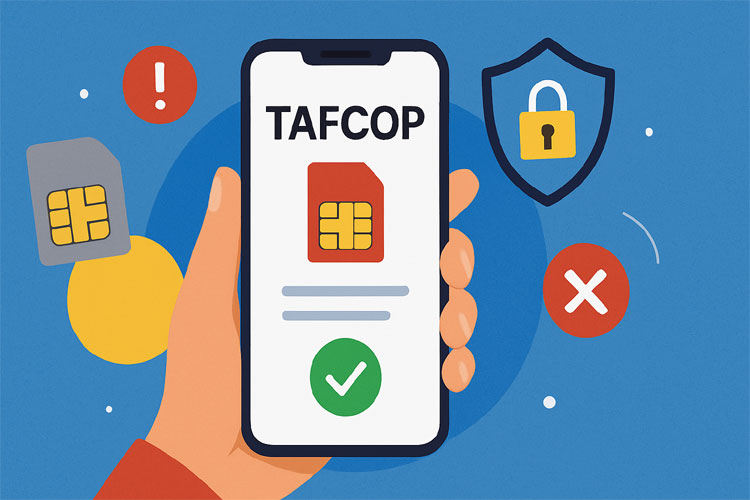In today’s digital world, SIM fraud is on the rise. According to recent government and media reports, the department has identified fake or fraudulent connections on a large scale and deactivated many SIM cards; some reports mention lakhs of connections, and action is ongoing. These statistics show that it is now more important than ever to be vigilant and regularly check which numbers are in your name.
What is tafcop. dgtelecome. gov. in, and why does it matter to you?
TAFCOP stands for Telecom Analytics for Fraud Management and Consumer Protection. It is a government service run under Sanchar Saathi to check the list of all connections linked to your Aadhaar or mobile number. If a stranger has taken a SIM in your name, you can report it and get it blocked. If this is not done, your identity, banking, and personal messages can be misused. You can check your details immediately by visiting the official portal.
How TAFCOP works – a simple step-by-step process
To access the website, open your mobile browser and visit the official site of TAFCOP/Sanchar Saathi.
- First tafcop dgtelecom gov.in login
Enter your mobile number and complete the captcha. - Receive the OTP and enter it.
- After login in, your screen will show all the numbers registered in your name and their status.
The process is simple and will take only a few minutes. If you prefer to use a mobile app, the Sanchar Saathi app is also available.
How many SIMs are in your name – what to check
On login, three types of status are usually displayed: the number you are currently using, the old numbers that you no longer use, and the numbers you do not know. If you have never taken a number or you have never taken it, report it as “Not My Number.” This small action can save you from big problems.
A small example
Suppose you use only one number, but the portal shows three numbers. At that time, you can immediately report those two unknown numbers and ask for their deactivation. This prevents misuse of OTP and banking logins linked to you.
Portal options in simple language
After login, three options appear in front of each number—Required, Not Required, and Not My Number.
Required means this is your active number.
“Not required” means you have used it earlier, but now you don’t need it.
“Not My Number” means it has been wrongly registered in your name or may be part of a fraud. With these options, you can easily control.
How to report a fake SIM and the importance of a Request ID
When you get an unknown number, choose Not My Number and submit the report. The system will give you a Request ID. This ID is very important. This ID is used for further inquiries, tracking, and support. Take a screenshot of it, save it as an SMS, or write it down somewhere. Without the Request ID, it may be difficult to track the further process.
How to track your report
The http://tafcop.dgtelecom.gov.in portal has a tracking section where you can check the status by entering the Request ID you received. The status will often be Pending, Under Process, or Closed. If there is a long delay, contact Sanchar Saathi’s helpdesk or email with the same Request ID. Official contact details and helpdesk information are available on Sanchar Saathi.
What are the harms of fake SIMs?
Fake SIMs can be misused in many ways. Whom to cheat depends on the fraudster’s approach. Some common risks are:
- Cheating people by creating WhatsApp or other messages in your name.
- Hijacking of OTPs of banking or payment services.
- Use of your number for wrong activities, which can lead to legal troubles.
Any of these situations can cost you time, money, and trust. So it is wise to investigate and report immediately.
Can your real number be blocked by mistake and solution?
Sometimes your actually used number can also be blocked due to wrong reporting. For this reason, check the number carefully once before reporting. If your number is blocked by mistake, you can appeal on the portal and improve the situation by uploading the required documents. Mobile operators also help in such cases, so take both ways.
Sanchar Saathi App and Official Support
Sanchar Saathi offers both app and website facilities. With the app, you can easily log in on mobile itself. Sanchar Saathi’s support email and helpline are available for any technical or process-related questions. Official contact and help desk information is given on the website, so use only official sources.
Easy ways to keep SIM identity safe
- Never share your OTP with anyone.
- Submit Aadhaar and KYC documents only at trusted centers.
- Do not click on suspicious apps or links.
- Check at least once a month on TAFCOP or Sanchar Saathi to see what numbers are in your name.
If you suspect any seller or PoS agent, report it. In many recent cases, action has been taken against such agents.
Common problems and quick solutions
- OTP did not arrive: There may be a delay in the network or operator; try again after some time.
- The wrong number is visible: Report it by selecting Not My Number and keep the Request ID safe.
- Login problem: Clear the browser cache and reopen or check for app updates.
Why can’t TAFCOP be trusted?
TAFCOP and Sanchar Saathi come under the government system. The data comes directly from the operators, and the process runs as per government standards. This means that the information you see is based on official and reliable sources. Therefore, regular checking can contribute greatly to your security.
What should you do from now on?
You have a simple and useful tool in your hand. Regularly visit TAFCOP or Sanchar Saathi and check the connections registered in your name. Report any unknown numbers immediately and keep the Request ID safe. A little precaution can save you from big losses. Your awareness is the biggest shield in digital security.
If you want to test now, visit the official https //tafcop.dgtelecom.gov.in/page and log in with your mobile number. Stay safe, stay alert, and make monitoring your mobile identity a habit.




